
The best way to fix a hole in the wall is to determine what the caused the hole and fix or repair that first. If the hole was caused by water or vermin for example, correct the cause before attempting to repair the hole. A hole when repaired should be invisible and we will discuss one method here. If the hole is more than you can handle, you can always call your Athens painting contractor to repair the hole and paint the wall seamlessly..
Depending upon what caused the hole in the first place the method of patching will vary. Let’s start with a hole in drywall. Assuming the hole was caused by a hammer or something striking the wall and not water damage, the patching is fairly easy. Lay out on the wall with a pencil a hole that is preferably square and is larger than the damaged area. It does not have to be a lot bigger but if you can reach a stud so much the better for anchoring the new patch piece. Using a sharp utility knife, carefully cut out the square and remove the damaged piece of drywall. Make sure the new edges are neat and crisp. If you are able to fasten to a stud, go ahead and nail the new piece of drywall in place. If not, cut a new piece of drywall two inches larger in each dimension. Make sure the new piece is the same thickness as the old drywall. Turn the new piece over on its face and again layout in pencil on the backside the size of the actual patch leaving a two inch border on all four sides. Now place something under the drywall that can be used as scrap and carefully cut through the drywall from the back on the pencil lines but being careful not to cut through the face paper. Remove all the gypsum leaving only the patch itself and a paper only, two inch border.
Turning the patch piece over once again you will see the face paper and two inch flaps all around.
Apply some spackle to the perimeter of the hole approximately three inches wide on all four sides.
Place a screw or nail in the center of the patch piece for you to hold on to while installing the patch.
Now place the piece into the hole and using your spackle knife carefully press the face paper into the wet spackle. Once the patch drywall is in place and the face paper is good and flat, no wrinkles, apply a second good coat of spackle over all the edges blending the new into the old. Once this coat of spackle is dry, remove the center holding screw and patch this hole when applying your third coat of spackle. The third coat is the most critical. This coat should cover the entire new patch and several inches out onto the adjoining old wall board. Lightly sand after drying to assure there are no edges and then prime paint the patch area. Do not skip the prime paint. If you try to paint directly over the newly patched area, the paint will “flash” causing the finished product to look different than the adjoining painted areas. No matter that you paint the entire wall. You are adding a new coat to a wall that already has several coats of paint. The patch area had none. Once the prime paint is dry go ahead and paint your wall. The patch will not show.
Article Source: https://EzineArticles.com/?expert=Peter_Ackerson